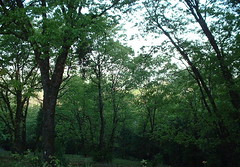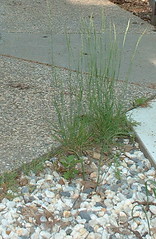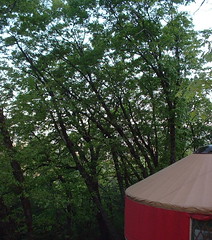The Future of Weaving
Grandiose title, eh? Consider this the opening volley in a potentially long conversation.
This past weekend was the annual Conference of Northern California Handweavers. There were seminars, lectures, vendors, a gallery of work, demonstrations and a fashion show. Attendance seemed adequate, not great, but classes were full. Vendors? I don't think they had enough customers. The usual walk-in traffic was very light.
There was time to have several conversations with fellow conference attendees, and the subject, as it has been for the past several years, has been: where are we headed?
From inklings a few years ago that we, as a group, are aging, that younger people are not joining us, to the certainty now that, as we become less able, and wish to sell off books, equipment, and yarns, there are few people interested in taking up the craft we have so earnestly pursued.
Local weaving guilds used to be the lifeblood of weaving instruction. Guilds have declined in numbers, and have a aging population, but most people can point to the main reason why: they usually meet mid-day, midweek. Working adults cannot attend regularly.
Some guilds do meet evenings, or weekends, and often their rosters reflect healthy numbers. But participation is definitely down, in guild activities, workshops, conferences, and shows.
What is the true weaving level, versus the simple numbers of members? What percentage of guild members actually weave, enter guild shows and conferences, and attend workshops? I have heard the estimate that 20% of weavers who subscribe to Handwoven actually weave. The rest are former weavers, loyal and still interested, or potential weavers, interested but not yet weaving.
Conferences around this country are the work of guilds, guild members and their volunteers. Fewer and fewer volunteers can be found, and more work is required of the few who do step up, making them less likely to want to repeat the grueling two to three year commitment required to stage a major show. Are conferences going the way of the Dodo?
There are classes at University level, certainly, but not nearly as many programs as were in existence when I started weaving. University trained weavers rarely join the guilds: there is a disconnect, whether intentional or not. One friend, who has a degree from RISD in weaving, says there is active denigration of the guild system in the school programs: *only little old ladies join the guilds, and their weaving is traditional and uninspired*. Hmm. How small minded, and how wrong. Lots of wonderful, creative work is done in quiet corners, by weavers who learned in guild workshops, and went home to self-study and effort.
One of my favorite conversations this weekend was with Vicky Fraser, of the California Rug Project. Native Californian Vicky has spent the last 12 years involved in spinning, dyeing and weaving this rug. The loom was custom built for her by her son, she has spun the 9 ply cotton warp, the wool weft, dyed the wool with natural dyes, taught several people to weave with her, and woven about two thirds of the way up the state. It is a lively and fascinating project, and a very beautiful rug: a legacy of the diversity of the state and a labor of love.
There were several pieces in the gallery that were breathtaking: I especially liked Marlene Golden's silk scarf. I had no camera (perhaps a good thing) but I will try to get a photo from Marlene.
I have no grand insights or real answers to the State of the Art. I don't know what is next, I don't know how to attract new people, and I don't know if the whole guild/conference thing needs to die a natural death. In the end, it is what it is, and will be what will be (how zen).
Any insights, comments, suggestions? If you don't wish to comment here, email me. I plan to rant and rave for a few more posts about teaching, learning and the value of time to create, among others (I know, run screaming now, it sounds exciting to me too).
I came home late last evening, and woke up to a very green yard:

It is amazing how quickly things change when one is gone. It is hard to capture the green glow everything has taken on: Spring has certainly sprung: the air is green, the light is green, the canopy has filled out and makes everything green. I have been gardening:

Or perhaps I should get to the gardening??
Mojo has taken the time to fling himself up trees:

And me? I'll retire to the yurt, the better to contemplate the state of the art, so to speak:

This past weekend was the annual Conference of Northern California Handweavers. There were seminars, lectures, vendors, a gallery of work, demonstrations and a fashion show. Attendance seemed adequate, not great, but classes were full. Vendors? I don't think they had enough customers. The usual walk-in traffic was very light.
There was time to have several conversations with fellow conference attendees, and the subject, as it has been for the past several years, has been: where are we headed?
From inklings a few years ago that we, as a group, are aging, that younger people are not joining us, to the certainty now that, as we become less able, and wish to sell off books, equipment, and yarns, there are few people interested in taking up the craft we have so earnestly pursued.
Local weaving guilds used to be the lifeblood of weaving instruction. Guilds have declined in numbers, and have a aging population, but most people can point to the main reason why: they usually meet mid-day, midweek. Working adults cannot attend regularly.
Some guilds do meet evenings, or weekends, and often their rosters reflect healthy numbers. But participation is definitely down, in guild activities, workshops, conferences, and shows.
What is the true weaving level, versus the simple numbers of members? What percentage of guild members actually weave, enter guild shows and conferences, and attend workshops? I have heard the estimate that 20% of weavers who subscribe to Handwoven actually weave. The rest are former weavers, loyal and still interested, or potential weavers, interested but not yet weaving.
Conferences around this country are the work of guilds, guild members and their volunteers. Fewer and fewer volunteers can be found, and more work is required of the few who do step up, making them less likely to want to repeat the grueling two to three year commitment required to stage a major show. Are conferences going the way of the Dodo?
There are classes at University level, certainly, but not nearly as many programs as were in existence when I started weaving. University trained weavers rarely join the guilds: there is a disconnect, whether intentional or not. One friend, who has a degree from RISD in weaving, says there is active denigration of the guild system in the school programs: *only little old ladies join the guilds, and their weaving is traditional and uninspired*. Hmm. How small minded, and how wrong. Lots of wonderful, creative work is done in quiet corners, by weavers who learned in guild workshops, and went home to self-study and effort.
One of my favorite conversations this weekend was with Vicky Fraser, of the California Rug Project. Native Californian Vicky has spent the last 12 years involved in spinning, dyeing and weaving this rug. The loom was custom built for her by her son, she has spun the 9 ply cotton warp, the wool weft, dyed the wool with natural dyes, taught several people to weave with her, and woven about two thirds of the way up the state. It is a lively and fascinating project, and a very beautiful rug: a legacy of the diversity of the state and a labor of love.
There were several pieces in the gallery that were breathtaking: I especially liked Marlene Golden's silk scarf. I had no camera (perhaps a good thing) but I will try to get a photo from Marlene.
I have no grand insights or real answers to the State of the Art. I don't know what is next, I don't know how to attract new people, and I don't know if the whole guild/conference thing needs to die a natural death. In the end, it is what it is, and will be what will be (how zen).
Any insights, comments, suggestions? If you don't wish to comment here, email me. I plan to rant and rave for a few more posts about teaching, learning and the value of time to create, among others (I know, run screaming now, it sounds exciting to me too).
I came home late last evening, and woke up to a very green yard:

It is amazing how quickly things change when one is gone. It is hard to capture the green glow everything has taken on: Spring has certainly sprung: the air is green, the light is green, the canopy has filled out and makes everything green. I have been gardening:

Or perhaps I should get to the gardening??
Mojo has taken the time to fling himself up trees:

And me? I'll retire to the yurt, the better to contemplate the state of the art, so to speak:


11 Comments:
One of the things that has been discouraging to me as a beginning weaver (and I ought to know as I've been a beginning weaver for over 6 years now :) is the cost of weaving. It's an expensive hobby. Equipment is expensive, materials are expensive, and classes and workshops are expensive especially if one must include travel, housing, and meals.
I suspect that many hobbyists (like me) dream of being able to sell enough handwovens to pay for their weaving. However items must necessarily be priced rather high to cover yarns, let alone time. Add to that the overhead costs of selling and the whole prospect becomes rather discouraging, especially when there is no guarantee of making any money at it!
I know all this probably sounds very whiney of me, but it's a reality that I have to live with. I love to weave and can pour over weaving catalogs for hours, dreaming of producing lovely projects with the different yarns. Fortunately I have a large stash of various mill ends, purchased very economically, and I am content with this.
At any rate, I can't help but wonder if cost might be a factor in why more people don't become involved with weaving.
I have always been interested in all kinds of fiber arts, but I am currently just spinning (on a drop spindle) and knitting. For me, the major factor is space. Looms take up a lot of space, whereas my curent knitting and spinning fits into its 2 square feet.
Until the last few years (okay, like 15 but remember how many years we're dealing with here) I have been a rather solitary self-taughyt fiber person. Online forums brought me into contact with other like-minded people and I (and my checkbook) haven't been the same.
I did join a guild when I began weaving, but meeting times and distance kept me away. I keep up my membership but don't really feel any connection. I agree with Leigh that weaving is expensive and takes up much more space than my other fiber pursuits. As more and more mills close and those bargain mill ends are a thing of the past this may be even more of a factor.
Nice lush yard! Your weeks of rain paid off.
I don't think weaving will disappear. Everything moves in cycles, things change, ebb and flow, nothing is static. At the moment, knitting is in the ascendant (and so is beading, and a few other crafts, so creativity in general is alive and well.)
Weaving is perhaps one of the more scary of the fibre arts to the uninitiated. Sue Lawty in the UK does great work with kids in schools with the aim of making it less so, using unusual and fun weft, sometimes withies as warp.
The internet is going to help a lot - the electronic connections we are weaving (hi, Leigh!) are going to keep things alive and developing. As for the guilds, I think that the same denigration is probably true in the UK, college textile courses do not deal with anything that I recognise as textile, and often not fibre either, so no doubt the reverse is true. But I do not think it a coincidence that the largest, most active and most innovative guild in the UK is the Online Guild, both for that reason and because so many people cannot manage the time to attend terrestrial meetings.
Vicky Fraser - did she happen to mention the strange English couple who fetched up on her doorstep one fine day? The rug is lovely, and I remember having such a good conversation about natural dyes.
Carol
i think there is a two-fold problem with weaving. at least for me. #1 is space. i just absolutely do not have room for a floor loom, and the smaller ones just don't do that much for me. i've tried & tried, and it just isn't happening (i love to see your stuff, though!). #2 is portablility. if i want to knit something, unless it's a completely unwieldy afghan or sweater for my fiance (he's 6'8", lol), it can go anywhere with me.
however, i would like to try triangle looms. those look fascinating. again, i've got the room problem (no yurt in my back yard, sigh)
I agree about the guild meeting times (our guild only has 1 study group that meets on a weekend--the rest are during work hours), but you don't need to belong to a guild to learn to weave or continue to weave. I was weaving for probably 12 years before I ever joined the guild--the weekend times interfered with the kid's sporting events. If someone really wants to weave, they will find a way. I grew up in a small town where no one wove. When I finally moved to the DC area, I happened across the Torpedo Factory catalog, which listed weaving classes. The hard part for me was finding the local resources (classes & equipment), and then good yarn sources. Nowadays you can order anything over the internet, but it wasn't that way when I started out. How do we publicize the availability of resources? How do people in small towns in the middle of nowhere find help? I do spinning demos at historic venues, and am always telling folks where they can go for lessons--and there are lots of folks interested.
Since reading your post yesterday, I have come across 2 women looking for weaving instruction for their early teen daughters. One is girl is a home schooler who wants to do a segment on weaving as part of her art requirement. The other is a 13 yo. who saw my guild's weaving demonstration at the local library and wants to pursue it. The second one already weaves beads on a bead loom. Happily, I was able to send them to a couple of qualified instructors.
I do think that things go in cycles. But I don't think that weaving is an "every person" thing the way that knitting can be. (IMO, so much the better! Since I can't see where the popularity of knitting has raised the quality in any way.)
I'm not real active in my guild. Although it's a weaving guild, only about 20% of the programs are weaving. I'm just not interested in shibori, mudcloth, beading, felting, etc. Yet these are the things that are popular and the core group in the weaving guild attends those programs. However when there is a weaving program where one has to thread the loom and show up for the workshop, I'm there.
This causes me to wonder if all these other fiber techniques aren't a distraction which keeps erstwhile weavers from actually getting to the loom? Many of these projects are faster. Some are more portable. And most do not require the same kind of physical and cognitive engagement that the loom requires.
It's true that everything we can learn about fibers (or anything else, for that matter) informs all of our work. But it's also true that an over abundance of things, ideas, etc. can get in the way of actually executing our ideas.
Thanks for providing this wonderful, thoughtful post and opening it up as a forum. Now, I must go make my hotel reservations for Convergence...I keep forgetting to do that!
Yurt p0rn. Oh how I love it.
As for your musings on the future of weaving, I doubt I have much to contribute to the conversation. I tried weaving, both on a floor loom in a beginning weaving class and on a tapestry loom. I hated the floor loom with a passion -- way too much prep work (that I did not enjoy) for the small amount of time actually spent weaving. The tapestry weaving was even more tedious, and I'm not that motivated to produce an art piece. Maybe I am symptomatic of a bunch of instant-gratification-loving baby boomers?
Knitting is a gateway drug for fiber activities because lots of folks like clothes, and knitting produces of-the-moment fashion relatively quickly as far as needle arts go. Weaving indeed can produce cloth for clothes -- although I don't know whether the sort of clothes currently shown in handwoven cloth attracts the fashion-loving younger set. Home decor stuff like dishcloths and placemats might attract some interest (love that gift towel, m'dear). And art weaving, like tapestry, gets others but now we are talking a small subset of folks.
Um, and my point was??
Oh yeah. Maybe there might be a way to start a Knitty-like on-line mag for weaving projects. *Gateway-drug* weaving projects to suck younger folks in. Right now, it doesn't seem like weavers have any way to reach the audience you are looking for.
i have woven off and on for the last 30 years. have 2 large looms in the garage. space in the house is a huge problem!
that and the prep time, i agree with claudia, knitting and spinning, instant gratification.
there is a wonderful place in delray beach florida, penelope's,
http://www.penelopesdelray.com/
run by a mother and daughter. they offer classes, or you can weave on one of their looms. my only problem is i am only close to delray in the summer, and then they use the looms for kid's summer camp.
As I am settling into my new apartment, one of my reasons for setting up my office/studio the way that I have, rather than how it was previously, is so that I can fit in a floor loom. I am hoping to have one before the end of the summer, even if it is a rental at first.
As for the guild, ours meets during the day. So do the offshot weaving and spinning groups. The knitting guild meets in the evenings but it is trapped in the 50s.
I suspect that interest in crafts is cyclical. But I also believe that the Internet will help keep all of the handcrafts alive.
My father has taken up wood turning and, while most of the members of his guild/club are older, they are constantly pulling in younger men. Is it because of the men and tools thing?
This comment has been removed by a blog administrator.
Post a Comment
<< Home